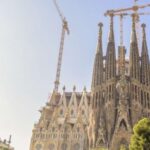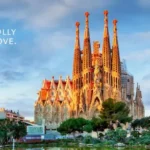
Barcelona's Sagrada Familia, designed by the visionary architect Antoni Gaudí, is not just a symbol of Catalan Modernism but also a marvel of architectural innovation. Its intricate façades and soaring towers encapsulate a rich narrative that intertwines faith, art, and the relentless passage of time.
In exploring The Intriguing History of Barcelona's Sagrada Familia, we uncover the challenges and triumphs faced during its construction, which began in 1882 and continues to this day. This iconic basilica stands as a testament to human creativity and devotion, drawing millions of visitors eager to witness its ever-evolving grandeur.
The Architectural Marvel of Sagrada Familia: A Historical Overview
The Sagrada Familia is a remarkable blend of Gothic and Art Nouveau styles, showcasing Antoni Gaudí's unique vision. This basilica is not merely a structure, but a living work of art that evolves with the passage of time, reflecting both spirituality and innovation. Gaudí's approach to architecture integrates natural forms, which is evident in the organic shapes and vibrant colors that define the building's façades.
Construction of the Sagrada Familia has seen numerous phases, each marked by distinct architectural features and techniques. For example:
- 1882-1926: The initial designs focused on traditional Gothic elements.
- 1926-1950: A shift towards modernism began after Gaudí's untimely death.
- 1950-present: Contemporary technologies have been increasingly utilized to aid in completing Gaudí's vision.
One of the most fascinating aspects of the Sagrada Familia is its symbolism. Every detail, from the intricate sculptures to the colorful stained glass, tells a story that resonates with visitors. The basilica is designed to evoke a sense of connection to the divine, making it a profound experience for those who enter.
Today, the Sagrada Familia remains a UNESCO World Heritage Site, attracting millions of tourists each year. Its ongoing construction, funded mainly by ticket sales, highlights a unique aspect of modern architecture—combining historical intentions with contemporary practices. This dynamic blend ensures that the Sagrada Familia continues to be a source of inspiration and wonder as it approaches its anticipated completion date.
Key Figures Behind the Construction of Barcelona's Sagrada Familia
Antoni Gaudí is undoubtedly the most prominent figure in the construction of the Sagrada Familia. His visionary approach transformed the basilica into a masterpiece that reflects both his deep religious faith and his innovative architectural style. Gaudí dedicated over 40 years of his life to this project, driving it forward with an unparalleled passion that is evident in every detail.
Another key figure in the Sagrada Familia's history is Francesc de Paula del Villar, who was the original architect before Gaudí took over in 1883. Del Villar's initial design incorporated traditional Gothic elements, which laid the groundwork for Gaudí's later reinterpretation. His contributions were crucial during the early stages of the construction, and his vision influenced the subsequent architectural direction.
Following Gaudí's tragic death in 1926, several architects took on the challenging task of completing his vision. Notably, Domènec Sugrañes i Gras, who worked closely with Gaudí, played a significant role in continuing the construction. He sought to preserve Gaudí's unique style while also adapting to the evolving architectural techniques of the time.
In recent years, modern architects and artisans have joined the project, utilizing advanced technology to bring Gaudí's ideas to fruition. This collaborative effort is vital in ensuring that the Sagrada Familia remains a living testament to creativity and devotion. As the project progresses, the integration of contemporary methods alongside traditional craftsmanship continues to shape the future of this architectural wonder.
The Symbolism in Sagrada Familia’s Design and Colors
The design of the Sagrada Familia is imbued with rich symbolism, reflecting Gaudí's deep religious beliefs and his appreciation for nature. Each element serves a purpose beyond mere aesthetics, aiming to guide visitors toward spiritual contemplation. Key aspects of the design include:
- Nature-Inspired Forms: The structure mimics natural shapes, symbolizing the connection between faith and the natural world.
- Light and Color: The use of stained glass creates a spectrum of colors, representing divine light and the emotional journey of the soul.
- Spiritual Narratives: Sculptures and carvings tell biblical stories, inviting reflection and deeper understanding of spiritual themes.
The colors used in the stained glass windows play a crucial role in conveying messages of hope, renewal, and spirituality. Each hue is thoughtfully chosen to enhance the atmosphere within the basilica. For instance, warm tones evoke feelings of joy and positivity, while cooler shades are often associated with tranquility and introspection. This careful selection of colors not only beautifies the space but also contributes to a profound spiritual experience for the visitors.
Moreover, the Sagrada Familia's façades are a tapestry of symbolism. The Nativity, Passion, and Glory façades are rich with iconography that illustrates the life of Jesus Christ. Each façade utilizes distinct color palettes to convey different moods and messages, enhancing the overall narrative. To illustrate this:
| Façade | Symbolism | Color Palette |
|---|---|---|
| Nativity | Birth of Christ | Warm, vibrant colors |
| Passion | Suffering of Christ | Dark, muted tones |
| Glory | Resurrection and Ascension | Bright, luminous colors |
In essence, the Sagrada Familia transcends its role as an architectural masterpiece; it serves as a canvas of spirituality and faith. The thoughtful integration of design and color underscores Gaudí's vision, inviting all who enter to reflect on their own spiritual journeys within this sacred space.
Exploring the Unfinished Masterpiece: The Ongoing Construction of Sagrada Familia
As visitors marvel at the Sagrada Familia, they are often struck by the fact that this grand structure is still under construction, a testament to the ongoing dedication of countless architects and artisans. Originally projected to be completed in 2026, the centenary of Gaudí's death, the timeline has shifted due to various challenges, including the impact of the COVID-19 pandemic. This evolving timeline further emphasizes the basilica's status as a living masterpiece, continually shaped by both historical context and modern techniques.
The construction process embraces a unique blend of tradition and innovation. Today, advanced technologies such as 3D modeling and computer-aided design are employed to interpret Gaudí's original plans. These tools enable contemporary builders to achieve the intricate details and organic forms that Gaudí envisioned, while also allowing for more efficient construction methods. This synergy between the old and new reflects a commitment to preserving the integrity of the design while adapting to modern needs.
Furthermore, the funding for the ongoing construction primarily comes from ticket sales and donations, ensuring that the project remains independent and true to its mission. This financial model not only supports the restoration and completion efforts but also fosters a sense of community among those who wish to contribute to Gaudí's legacy. Visitors become part of the story, knowing their contributions help bring this extraordinary vision closer to completion.
As the Sagrada Familia progresses, each added stone and sculpted detail becomes a chapter in its rich narrative. This commitment to completion not only honors the vision of Antoni Gaudí but also invites future generations to appreciate the intersection of faith, art, and architecture. With every milestone achieved, the unfinished masterpiece continues to inspire awe and wonder among all who encounter it.
Cultural Impact of the Sagrada Familia on Barcelona and Beyond
The Sagrada Familia's cultural impact extends far beyond its physical structure, influencing not only the city of Barcelona but also the broader context of architectural and artistic movements worldwide. As a quintessential representation of Catalan Modernism, it has inspired countless artists and architects to explore the integration of spirituality and nature in their work. The basilica serves as a vital educational resource, fostering appreciation for innovative design and the complexities of modern architecture among students and professionals alike.
Furthermore, the Sagrada Familia has become a symbol of resilience and perseverance, particularly in the face of challenges during its lengthy construction. This narrative resonates with many, reinforcing the importance of dedication to one’s vision. With its ongoing construction, the basilica embodies a dynamic interplay between the past and the future, showcasing how traditional techniques can blend with contemporary advancements. This ongoing journey motivates artists and cultural enthusiasts to engage in discussions about preservation, innovation, and the evolution of cultural identity.
In addition to its architectural significance, the Sagrada Familia plays a crucial role in the local economy and tourism sector. It attracts millions of visitors each year, generating substantial revenue that contributes to Barcelona's cultural landscape. The influx of tourists not only enriches the city but also supports local businesses, from restaurants to artisan shops. Moreover, the basilica acts as a cultural hub, hosting various events that promote community engagement and foster a sense of unity among Barcelona's residents.
Ultimately, the Sagrada Familia transcends its role as a mere architectural landmark; it is a beacon of inspiration for generations. Its profound impact is felt in various spheres—artistic expression, community development, and cultural heritage—which together create a vibrant tapestry that reflects the collective spirit of both Barcelona and the world. As the construction continues, its legacy is poised to grow, inviting future generations to partake in the ongoing story of this extraordinary work of art.
Visiting Sagrada Familia: Tips for an Unforgettable Experience
When planning your visit to the Sagrada Familia, it's essential to consider the best time to go. Early morning or late afternoon are ideal for avoiding large crowds and enjoying a more serene experience. Additionally, booking your tickets in advance can save you time and grant you access to guided tours that provide deeper insight into Gaudí's masterpiece. Make sure to check the official website for any special events or closures before your visit.
While exploring the basilica, take a moment to appreciate its astonishing details. Pay attention to the stained glass windows, which create a kaleidoscope of colors that change throughout the day. Also, don't miss the opportunity to wander around the surrounding park, where you can capture stunning photographs of the intricate façades. Here are some tips to enhance your experience:
- Use headphones: If you opt for an audio guide, it will enrich your understanding of the architecture and symbolism.
- Visit the towers: Taking the lift to the top provides a breathtaking view of Barcelona and a unique perspective of the basilica's structure.
- Plan for reflection: Allocate time for quiet contemplation in designated areas, allowing the spiritual ambiance to resonate.
Another crucial aspect of your visit is to respect the sacred environment of the Sagrada Familia. As a functioning basilica, it is important to maintain a level of decorum, especially during religious services. Be mindful of your surroundings and adhere to any posted guidelines, which help preserve the sanctity of this architectural wonder. With these considerations in mind, your visit to the Sagrada Familia will surely be an unforgettable experience.
 Exploring the Majestic Sagrada Familia in Barcelona: A Guide to Booking Tickets
Exploring the Majestic Sagrada Familia in Barcelona: A Guide to Booking Tickets Exploring the Majestic Interior of La Sagrada Familia in Barcelona
Exploring the Majestic Interior of La Sagrada Familia in Barcelona Exploring the Majestic Sagrada Familia in Barcelona's Vibrant District | Travel Guide
Exploring the Majestic Sagrada Familia in Barcelona's Vibrant District | Travel GuideIf you want to know other articles similar to The Intriguing History of Barcelona's Sagrada Familia you can visit the category WHERE YOU CAN GO.
Leave a Reply










Read more!